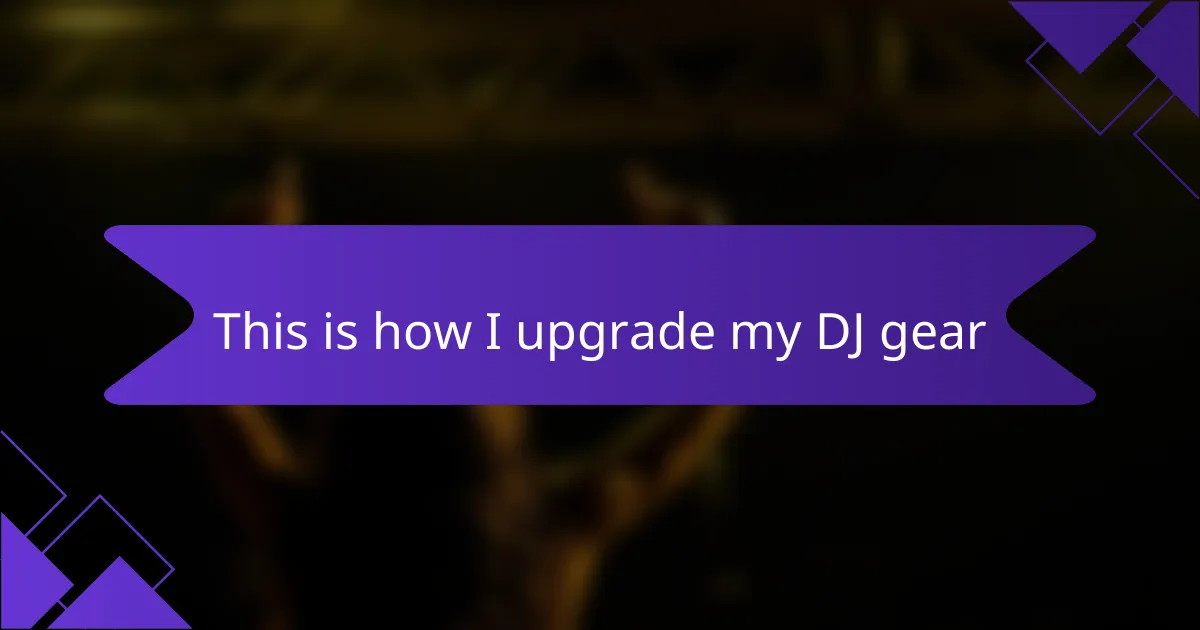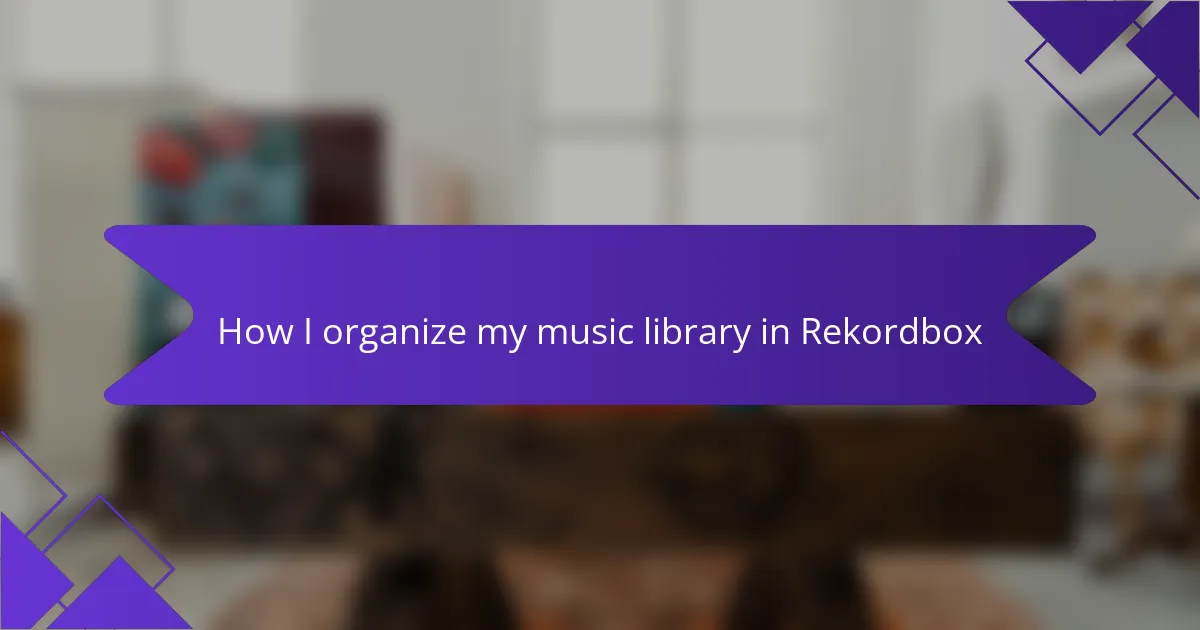Key takeaways
- Mixing genres enhances creativity, audience engagement, and cultural unity by combining diverse musical elements.
- Popular combinations like jazz and hip-hop or EDM and rock lead to innovative sounds and electrifying performances.
- Techniques such as beatmatching and key mixing are essential for creating seamless transitions between genres.
- Challenges include managing transitions, understanding distinct genre elements, and balancing the emotional impact of the music.
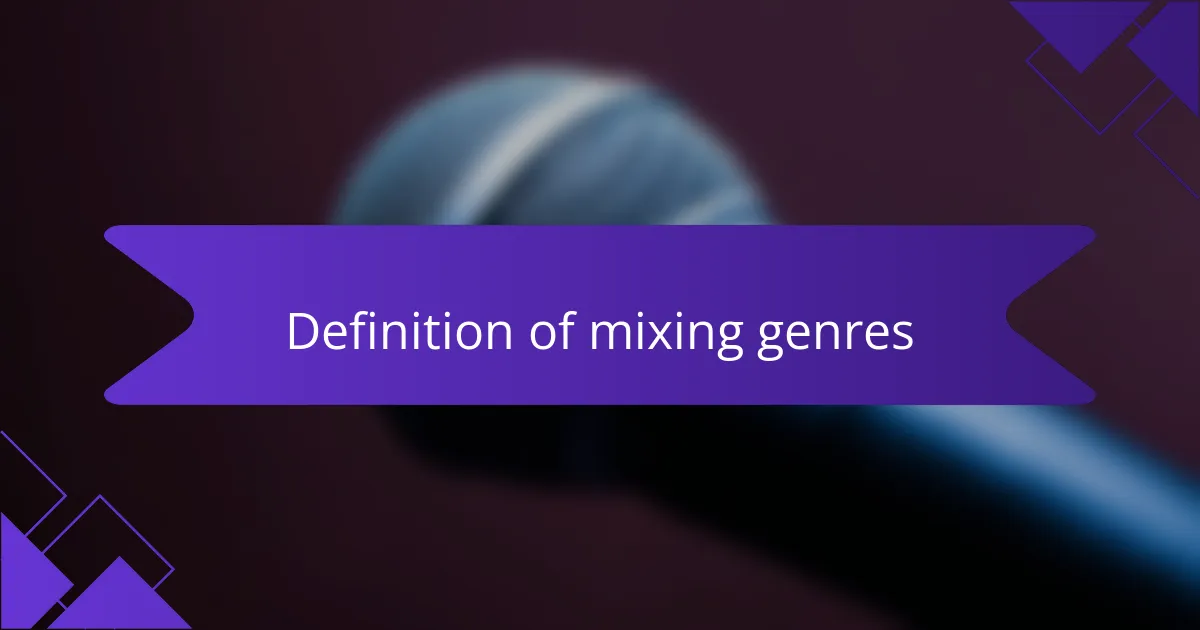
Definition of mixing genres
Mixing genres refers to the creative practice of blending different styles of music to create something fresh and exciting. As a DJ, I’ve often found that combining elements from various genres can not only redefine a track but also elevate the crowd’s energy in unexpected ways. For example, I once mixed a hip-hop beat with classical strings, and the surprise in the audience’s faces was absolutely priceless.
In my experience, the beauty of mixing genres lies in finding surprising connections between seemingly unrelated styles. The emotional response elicited from such experiments can be profound; I’ve seen listeners connect with music on a personal level, tapping into nostalgia or joy. Here’s a quick snapshot of what mixing genres entails:
- Genre Fusion: Combining rhythms, melodies, and instrumentation from different musical styles.
- Creative Expression: A platform for artists and DJs to showcase their individuality and innovation.
- Audience Engagement: A means to enhance the listener’s experience and keep the energy alive in a performance.
- Cultural Influence: Reflecting diverse musical backgrounds and fostering a sense of unity through sound.
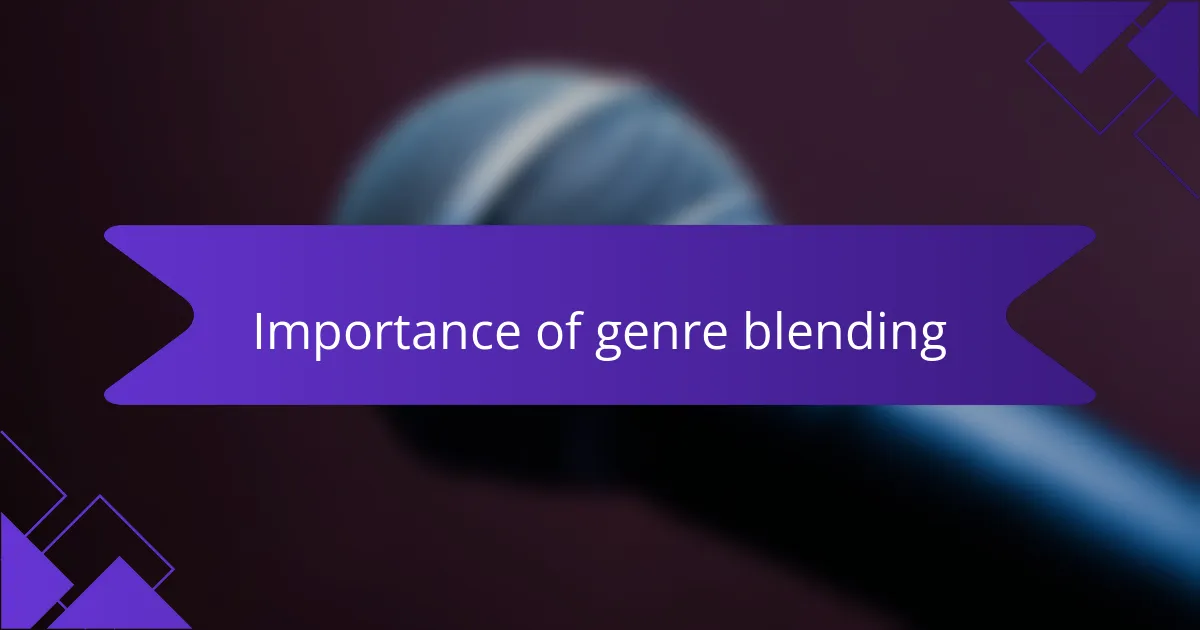
Importance of genre blending
Blending different music genres holds immense importance for both the artist and the audience. I’ve experienced firsthand how an unexpected transition from electronic beats to acoustic instruments can create a magnetic atmosphere. It often leaves listeners wondering, “How did they make that work together?” This curiosity not only enhances their experience but also broadens their musical palate.
In my own DJ sets, I’ve noticed that genre blending allows for a unique form of storytelling. When I mix reggae rhythms with pop vocals, it’s like weaving a tapestry of diverse emotions and cultural influences. The engagement from the crowd is palpable; they feel seen and heard, almost as if the music reflects their own identities.
Moreover, genre blending encourages innovation and change within the music scene. I remember when I introduced a funk section to a trance set. The energy shifted dramatically, and the crowd responded by dancing like never before. It’s just one example of how merging styles can transform a performance and create powerful memories that resonate long after the last beat drops.

Popular genre combinations
When it comes to popular genre combinations, the beauty of mixing music is that it often leads to innovative and exciting sounds. For instance, the fusion of jazz and hip-hop has become a significant trend, creating a laid-back yet vibrant atmosphere that I’ve personally witnessed energizing crowds at various events. I remember spinning a track that seamlessly blended a smooth saxophone riff with a hard-hitting beat, and it was incredible to see how people reacted—dancing with an effortless groove.
Another great combination I love is electronic dance music (EDM) and rock. The high energy of EDM complements the raw power of rock guitar, leading to memorable moments on the dance floor. I’ve seen these genre mashups take over festival stages, with artists dropping anthems that make the audience feel both nostalgic and exhilarated. Here’s a quick list of some popular genre combinations that are making waves:
- Jazz + Hip-Hop
- EDM + Rock
- Reggae + Dubstep
- Country + Pop
- R&B + Trap

Techniques for seamless mixing
When it comes to mixing different music genres, I find that blending tracks with complementary keys makes a noticeable difference. Matching the energy levels also creates a seamless flow, preventing any jarring transitions that can disrupt the vibe on the dance floor. I often think about how every genre has its unique rhythm and emotion, and finding that common ground between them can create a magical experience.
One technique I frequently use is beatmatching, which involves aligning the tempos of two tracks. It’s a skill that takes practice, but the payoff is so rewarding when you see the crowd react positively to a well-executed mix. Recently, I tried transitioning from classic rock to an upbeat funk track, and by carefully manipulating the beats, I created an exhilarating moment that really connected with the audience.
Here’s a comparison table outlining common techniques for seamless mixing along with their benefits:
| Technique | Benefits |
|---|---|
| Beatmatching | Ensures tempo consistency between tracks. |
| Key Mixing | Creates harmonic blends, enhancing the musical experience. |
| Use of Effects | Adds depth and character to transitions between genres. |
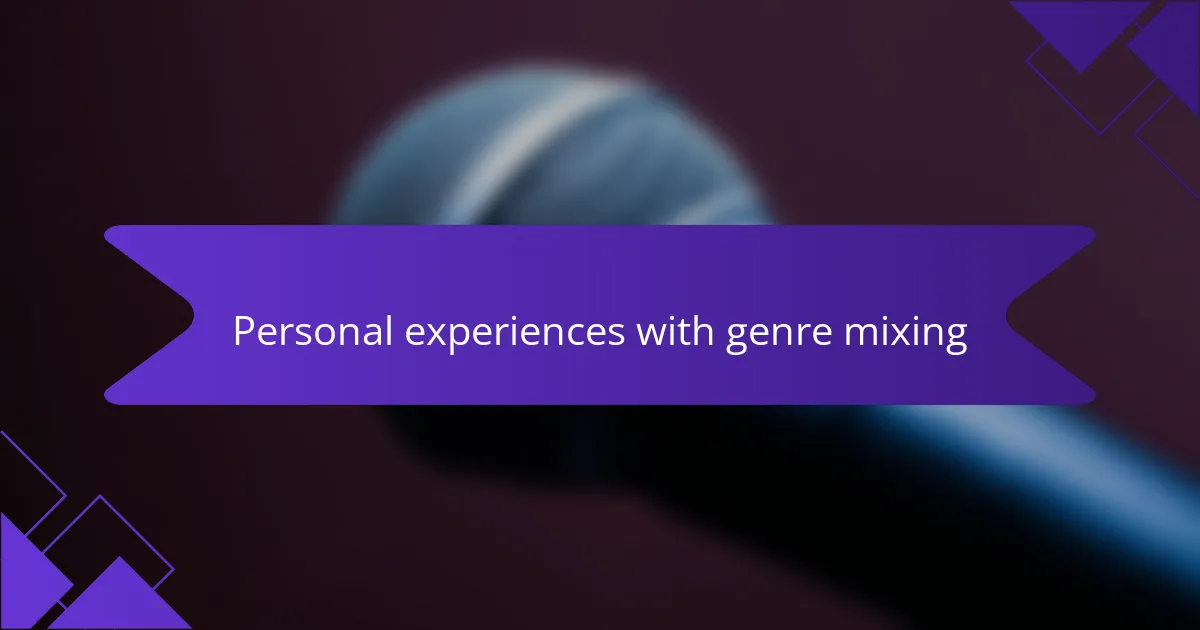
Personal experiences with genre mixing
When I think about mixing different music genres, I can’t help but recall the electrifying nights I’ve spent behind the decks. One time, I transitioned from a smooth jazz track into an upbeat reggae tune. The crowd’s reaction was unforgettable. Their energy surged as they danced, creating a moment that felt both spontaneous and exhilarating.
I’ve also noticed that some genres blend seamlessly, creating unexpected yet harmonious sounds. For instance, I often combine electronic beats with acoustic instruments. The contrast brings a unique flavor, and the audience tends to appreciate the creativity. It’s rewarding to see people connect through music in ways I often didn’t anticipate.
Here’s a comparison of different genre blends that I’ve experimented with:
| Genre Combination | Impact on Audience |
|---|---|
| Jazz + Reggae | High energy and relaxation |
| Electronic + Acoustic | Innovative and engaging |
| Hip-Hop + Rock | Powerful and nostalgic |
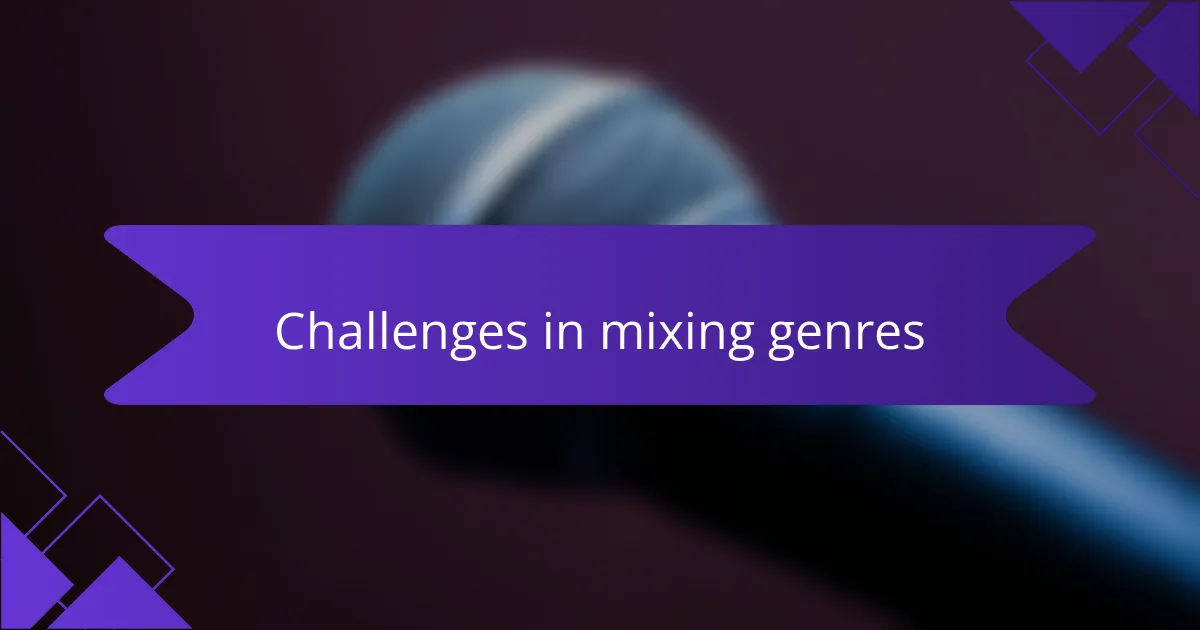
Challenges in mixing genres
Mixing different music genres is certainly an exciting venture, but it does come with its challenges. For instance, the transition between two distinct styles can sometimes feel jarring, which can disrupt the flow of a set. I remember a time when I tried to blend a classical track with a heavy electronic beat; the audience’s reaction was mixed, and I learned firsthand that not every combination works harmoniously.
Another challenge lies in understanding the core elements of each genre. For example, the tempo and structure may differ widely, requiring a careful balance to create a seamless experience. I once spent hours crafting a mix that would appeal to both rock and hip-hop fans, only to find that maintaining energy throughout was more difficult than I expected.
Lastly, there’s the emotional connection to consider. Each genre often evokes a different set of feelings, and as a DJ, it’s crucial to navigate those emotions thoughtfully. I strive to create an atmosphere where the audience can relate to the mix, but finding that balance can sometimes feel like walking a tightrope.
| Challenge | Description |
|---|---|
| Transitional Issues | Difficulty in creating seamless transitions between genres. |
| Understanding Elements | Need for a grasp of different tempos and structures. |
| Emotional Connection | Balancing the diverse emotions evoked by varying genres. |

